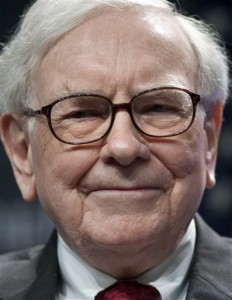WASHINGTON—Unfazed by predictions of the death of newspapers, billionaire Warren Buffett is pumping more money into print.
In the past year, one of the world’s richest men and sharpest investors has put some $300 million into an industry that some view as heading the way of the horse and buggy.
Buffett’s Berkshire Hathaway holding company late last year bought his hometown newspaper, the Omaha World-Herald, along with related assets in a $200 million deal some analysts viewed as a sentimental move.
He followed with a $142 million deal last month to buy Media General, a chain of 63 newspapers.
He added $2 million to Lee Enterprises, owner of the St. Louis Post Dispatch and Arizona Daily Sun. That is in addition to other holdings, including The Buffalo News and a stake in The Washington Post Co.
“I believe newspapers that intensively cover their communities will have a good future,” Buffett said in a message last month to his newspaper employees.
He said Berkshire “will probably purchase more papers in the next few years” and that he will “favor towns and cities with a strong sense of community.”
Still, the investment comes amid dire predictions for the newspaper industry, which has been battered by sharp drops in print circulation and advertising, and getting only modest revenues from online services.
A research note from the financial firm Moody’s earlier this month gave the US newspaper industry a “negative” outlook, saying that digital initiatives are failing to make up for “significant secular pressures.”
“Although newspaper companies seek to capitalize digital revenue through an array of channels, it’s unlikely that these gains will be large enough to offset print losses,” Moody’s analyst John Puchalla wrote.
“A complete transformation away from print entirely would eliminate the sizable costs of print production and distribution, but the revenue loss is still too great for companies to make the switch yet.”
Analysts say Buffett, the world’s third-richest individual with a net worth estimated at $44 billion, is doing what he does best: making a “contrarian” bet by investing in a company or sector beaten down by negative sentiment.
“Newspapers are one tenth of the price they were a decade ago,” said Ken Doctor, a media analyst with the research firm Outsell.
Doctor said Buffett is finding value in these companies because they often own hard assets, including real estate and broadcast properties, and have a strong brand name in their communities.
“These are great community assets, they have great brands,” Doctor told AFP.
“Buffett is, at base, an opportunistic investor… See a business, or industry deep in the doldrums, and think you can leverage money out of a deal, one way or the other, and you’ve got an opportunity.”
In an interview with The Washington Post, the 81-year-old Buffett said his move was “not a soft-headed business decision.” But the investor said he sees prospects best for newspapers in smaller cities with “a feeling of community.”
Still, to make the investment pay off, Buffett will have to find a way to stem losses in the news business, and he has indicated he will seek a new “digital strategy” for the companies.
“We must rethink the industry’s initial response to the Internet,” Buffett said in his message.
“The original instinct of newspapers then was to offer free in digital form what they were charging for in print. This is an unsustainable model and certain of our papers are already making progress in moving to something that makes more sense.”
Dan Kennedy, a journalism professor at Northeastern University, said Buffett’s strategy is not yet clear.
“If he means that newspaper companies should use their websites to come up with complementary content – for instance, breaking news, blogs, features that aren’t in the paper, that sort of thing – then he may be on to something interesting,” Kennedy said.
“But if he’s got some sort of ‘back to print’ crusade in mind, then I’m skeptical.”
Doctor said, “We may find out, looking back, that Buffett is just another greater fool, having believed his buy was close enough to the bottom to justify. Or we may see the code broken well enough on new business models.”
